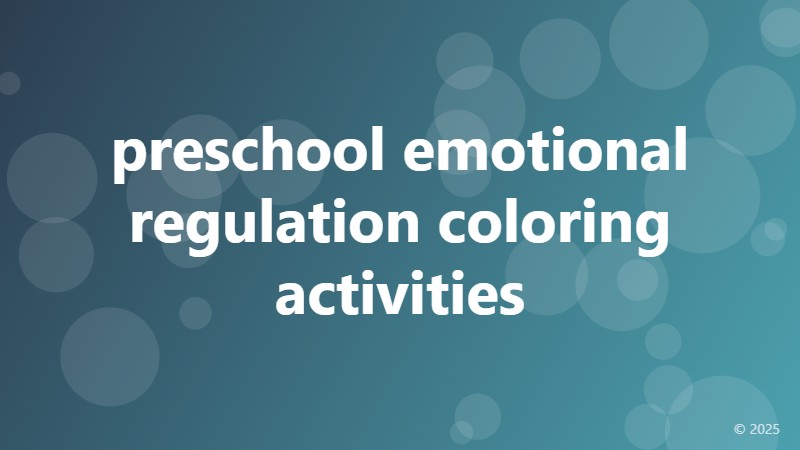preschool emotional regulation coloring activities

Teaching Emotional Regulation in Preschool: The Power of Coloring Activities
Preschool is a critical period in a child's life, where they learn to navigate their emotions, develop social skills, and build a strong foundation for future academic success. One essential aspect of preschool education is teaching emotional regulation, which enables children to recognize, understand, and manage their feelings in a healthy manner. Coloring activities, a staple in many preschool classrooms, offer an engaging and effective way to promote emotional regulation in young children.
Why Emotional Regulation Matters in Preschool
Emotional regulation is crucial for preschoolers, as it helps them develop self-awareness, self-control, and resilience. When children can effectively manage their emotions, they're better equipped to handle frustrations, make friends, and focus on learning. Conversely, poor emotional regulation can lead to behavioral problems, decreased academic performance, and strained relationships with teachers and peers.
Coloring Activities: A Fun and Interactive Way to Teach Emotional Regulation
Coloring activities, such as drawing, painting, or coloring, offer a unique opportunity to teach preschoolers about emotional regulation. These activities allow children to express their feelings, explore different emotions, and develop essential skills like self-awareness, self-regulation, and empathy. Here are some ways coloring activities can promote emotional regulation in preschoolers:
Identifying and Labeling Emotions: Provide preschoolers with a range of coloring sheets featuring different facial expressions or scenarios that evoke various emotions (e.g., happiness, sadness, anger, fear). Ask them to identify and label their emotions, encouraging them to explore and understand the emotional spectrum.
Expressing Emotions through Art: Offer preschoolers a blank sheet of paper and a variety of art supplies (e.g., crayons, markers, paint). Encourage them to create artwork that represents how they're feeling, promoting emotional expression and release.
Regulating Emotions through Breathing and Movement: Incorporate deep breathing exercises and gentle movements into coloring activities. This helps preschoolers develop self-regulation skills, calming themselves and managing their emotions in a healthy way.
Empathy and Perspective-Taking: Use coloring activities to encourage empathy and perspective-taking. For example, ask preschoolers to imagine how a character in a story might be feeling, and then create a drawing that represents that emotion.
Incorporating Emotional Regulation into Your Preschool Curriculum
To make the most of coloring activities for emotional regulation, incorporate them into your preschool curriculum in a consistent and intentional manner. Here are some tips to get you started:
Make it a Routine: Set aside time each week for coloring activities focused on emotional regulation.
Use a Variety of Materials: Experiment with different art supplies and materials to keep preschoolers engaged and interested.
Encourage Open-Ended Conversations: Use coloring activities as a springboard for open-ended conversations about emotions, encouraging preschoolers to share their thoughts and feelings.
Be Patient and Supportive: Remember that teaching emotional regulation is an ongoing process. Be patient and supportive, offering guidance and reassurance as preschoolers navigate their emotions.
By incorporating coloring activities into your preschool curriculum, you can provide young children with a fun and interactive way to develop essential emotional regulation skills. By teaching preschoolers to recognize, understand, and manage their emotions, you'll set them up for a lifetime of social, emotional, and academic success.